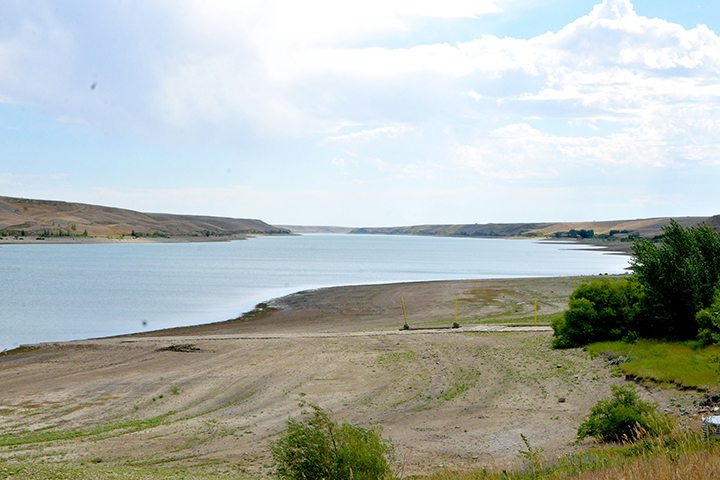Current Temperature
-11.6°C
Chin expansion plan under review by the Province
Posted on September 5, 2024 by Taber Times Taber Times File Photo
Taber Times File PhotoBy Cal Braid
Taber Times
Local Journalism Initiative Reporter
On Aug. 13, the St. Mary River Irrigation District (SMRID) released a joint notice of filing with the Natural Resources Conservation Board (NRCB) and the Ministry of Environment and Protected Areas (MEPA). The notice is the latest step as SMRID moves ahead on the Chin expansion plan, its biggest dam project in decades and one that will restructure the landscape to vastly increase the regional water storage capacity.
The expansion project intends to construct a new dam which will result in a larger reservoir. The new dam will be approximately 40 meters in height and is expected to flood approximately 650 hectares of privately held land within Chin Coulee.
Chin Reservoir is an off-stream storage reservoir located roughly in the middle of the SMRID system, approximately 10 kilometres southeast of Coaldale. It’s the largest off-stream reservoir within the SMRID and has a current storage volume of 154,320 acre-feet, according to the District. The reservoir is currently impounded by two dams: Chin West and Chin East.
According to the District, those dams were completed in 1955 and no major modifications have been completed since construction. Water enters the Chin reservoir from the SMRID main canal, through the Chin hydro plant, and through the Chin Chute. The only outlet on the reservoir is the irrigation outlet structure on the Chin West Dam, which discharges into Stafford Reservoir, supplying the main canal.
Rehabilitation of the Chin west dam and its associated structures is planned as part of the project. The associated structures are Chin Chute and the irrigation outlet. Both lack sufficient capacity and are reaching the end of their service life after 70 years.
The Chin West Dam, completed in 1955, ‘settled’ down about two metres after construction. To accommodate higher water levels, the dam will be re-established and raised to an appropriate height.
The District’s expansion plan is contingent upon approvals before the dam project can begin. It filed an NRCB application and submitted an environmental impact assessment (EIA) to the NRCB and MEPA to conduct impact reviews. Water management projects are required to complete these under the Environmental Protection and Enhancement Act.
Approvals for the project are required under the NRCB Act and the Water Act. The application is not considered complete until the filed application has been reviewed and any deficiencies supplemented.
In a 2022 review of the project’s impact assessment, Steven Guilbeault, minister of environment and climate change, considered the potentially adverse direct or incidental effects and public concerns related to those effects.
Guilbeault’s analysis of the proposal came to several conclusions. First off, “the Canada Infrastructure Bank (CIB) is expected to provide financial assistance, in the form of a loan to be repaid by the proponent (SMRID), for the purpose of enabling the project to be carried out. The CIB is responsible for meeting all of its legal obligations, including responding to the duty to consult to Indigenous groups and ensuring that the project has met environmental assessment and other regulatory requirements.”
The second conclusion was that the project must be carried out in compliance with provincial and federal legislation, including the Fisheries Act; the Species at Risk Act; the Migratory Birds Convention Act; and the Canadian Environmental Protection Act. Other applicable legislation includes the Historical Resources Act, Water Act, Wildlife Act, Public Lands Act, Soil Conservation Act, and Weed Control Act.
SMRID General Manager David Westwood said that when Guilbeault reviewed the project back in ‘22, he decided that it didn’t warrant federal approvals and passed it back to the Province to make the determination. He confirmed that the EIA needs to fulfil all the legislated acts listed above.
The new east dam will be a major undertaking. Construction will occur approximately 10 kilometres downstream of the existing Chin East Dam. The structure will be built with earthen fill and include an emergency overflow structure to accommodate the inflow flood. After construction, the reservoir’s full supply level will be raised about 2.6 metres to 864 metres. The newly inundated area of the reservoir is situated entirely on privately owned land and the reservoir enlargement will increase the surface area of Chin reservoir by 42 per cent.
Westwood explained where the project stands as of August 2024. He told Southern Alberta Newspapers that, “The notice that you received was them notifying the public that both the NRCB and MEPA had received the actual EIA and now they’re in the process of reviewing it. Their regulatory team will go through the mass of documents. Basically, it lists out all the different types of studies that went into the EIA, and now it’s with those arms of government to review that technical information and determine whether the project can move forward.”
While there’s no definitive timeline on the review by the regulatory team, Westwood is hopeful that by the end of 2024 the District will have an indication of the project’s status. If the EIA falls in line with the requirements, an official approval by early 2025 would put the project on pace to begin constr
Leave a Reply
You must be logged in to post a comment.

